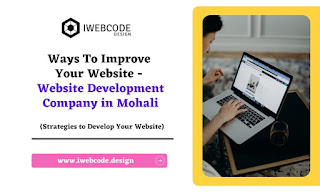A Complete Guide To Website Navigation
A website is like a city—both need to be
organized logically and built strategically so people don’t get confused. Your
sitemap and structure are the backbones of excellent web navigation serving as
your blueprints. Each site contains layers of navigational elements such as
menus, icons, and footers that direct visitors from one website to the next.
Simple, straightforward navigation will give
your guests a smooth experience where they can easily navigate from page to
page, whatever action you wish to take.
You may have beautiful content and stunning
images, but you may lose guests along the way if the website is confusing to
navigate.
Efficient navigation will significantly
affect the popularity of your website—from the number of time users spend on
your site to your SEO rankings and more. Discover the essentials of excellent
navigation here, and learn how to do it on your website.
The Basics of Great Website Navigation:
Not only does the website look amazing, but
it should also sound good too. Excellent navigation can lead visitors back time
and time again. Remember the ambitions of the customers and strive to work out
the smoothest way to get them there. Next, we’ll dig into the website menus and
try out other features that help the website navigate easily.
Menu Navigation
The menu navigation bar is the bread and
butter of the website design, and there are several types of navigation bars
that you can select based on the style of the website and you need them. Your
menu should be available and open to your users—don’t make them hunt. Make sure
all the essential pages are available from your menu. Below, explore the
various menu styles to determine which menu is better tailored to your site.
Horizontal
Menu
The Horizontal Navigation Bar is one of the
most simple and common navigation bars in web design. The navigation menu bar is placed at the top of
the website with the primary web pages listed. These names or logos of your
website should be clear so that the user knows that these are the essential
pages of your website. Commonly, drop-down menus come hand in hand with
horizontal bars as they help save screen space. However, long drop-down menus
with so many choices can make it impossible for consumers to look at all the
options at one glance.
Vertical
Menu
Introducing the hamburger menu, also known as
the sidebar menu, is composed of three stacked lines that must be tapped on to
view the page menu on your site. The hamburger menu theory is that it naturally
makes more room on the homepage when accessed from a mobile site. Criticism of
the hamburger menu involves a lower discoverability rate—or, in other words,
many people could actually not appreciate the need to click on it.
Since it is less obvious, it also proves to
be less effective. However, if your guests seem to be more web-savvy, the
hamburger menu can be a perfect way to place all the attention on the
page—while believing that your visitors will know how to work around the menu.
Anchor Menu
An anchor menu is an excellent tool for
one-page websites or long pages where a lot of scrolling is required. Anchor
helps the visitor click on the menu item and instantly drop down to where it
appears on the list. They are an excellent
navigation tool for websites with a lot of content. Anchor links allow your
website visitors to easily access helpful information without having to scroll
up, down, or move to another page. Learn how to add anchor links to the Wix
website.
Hamburger
Menu
An anchor menu is an excellent tool for
one-page websites or long pages where a lot of scrolling is required. Anchor
helps the visitor click on the menu item and instantly drop down to where it
appears on the list. They are an excellent navigation tool for websites with a
lot of content. Anchor links allow your website visitors to easily access
helpful information without having to scroll up, down, or move to another page.
Learn how to add anchor links to the Wix website.
Beyond
Menus: More Great Navigation Features:
Breadcrumbs
You never want your guest to get lost about
where he or she is when visiting your website—and it’s easy to keep your guests
updated about their actual location. Breadcrumb navigation is mostly used on
pages with a vast volume of content. Breadcrumb appears as a highlighted link,
and it’s a simple way for visitors to search your page, enabling them to sort
content while easy how to get back home.
Sticky
Menu
A sticky menu is a particular interface
feature where the menu is locked (stuck) no matter where you connect to the
website. Instead of spending time going back to the top of the web page to
navigate the menu icon, you already have an easily available menu that speeds
up your navigation experience.
Website
Page Names
When explaining pages on your menu, be as
descriptive as possible while keeping it simple. Often static explanations of
websites, including Images, won’t give the users the answers to their
questions. The primary objective of each page should be transparent to the
consumer. ‘Videos’ just defines the
structure of the website rather than the content of the page. Using only
one word to your page titles will tell your guests what they need to hear.
E.g., try ‘Testimonial Videos.’ This offers the customer a more detailed
overview of what they can hope to see.
Hyperlinks
Websites also connect words or phrases to
external and internal pages to provide visitors with more detail. The nature of
these hyperlinks is to help your users—make sure they are highlighted, so your
users know where to press. This can be adequately achieved by underlining or
changing the hue of your related text.
Let’s presume you wrote a blog post about a new product in your online shoe
shop. In the phrase: “Our brand-new boots are made of 100% fair trade leather
from local suppliers,” you may want to add “local suppliers” to your leather
supplier’s website. By opting to connect “local suppliers,” the reader would
have a clear idea of where the link leads—and can press if they want to learn
more.
Buttons:
Buttons may sound like a prominent feature
for excellent navigation, but using them cleverly isn’t that easy. Use buttons
sparingly—don’t overcrowd the website with buttons that link to several sites.
Buttons can stand out from your website and look clickable, which indicates
that you can play with contrasting colors, borders, and key text, implying that
this feature is ‘action-based.’ Shop Now, Sign Up, or Subscribe are, of course,
common choices.
Great navigation is essential to give your
guests a great deal of experience on your website. Check your friends and
family navigation website and see how they can easily find pages or content on
your website. The benefit of working on a site is that nothing is definitive.
Change, edit or integrate plugins and features that can help enhance the user
experience on your website. And don’t be afraid to change things. Small tweaks
could make a huge difference.




Comments
Post a Comment